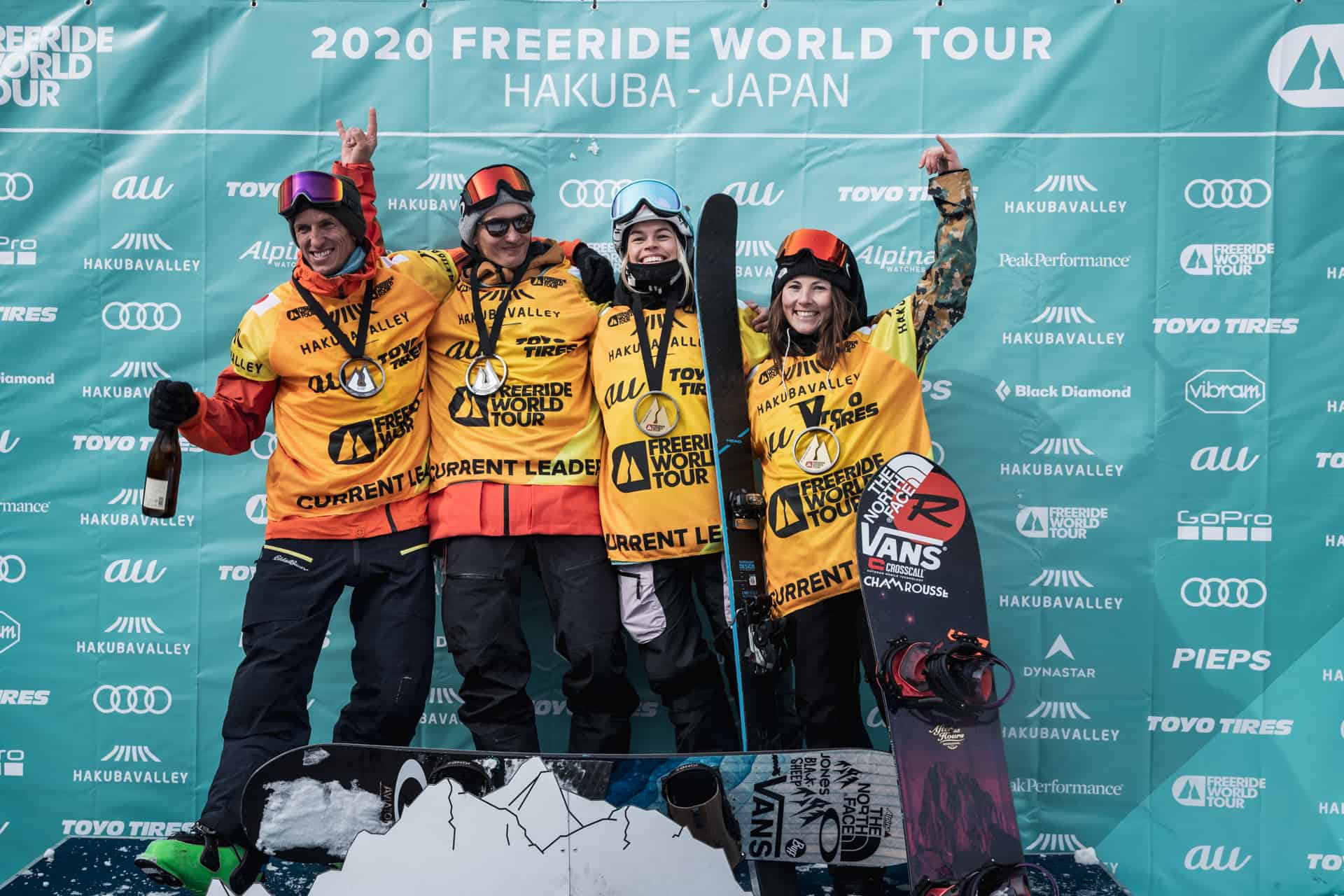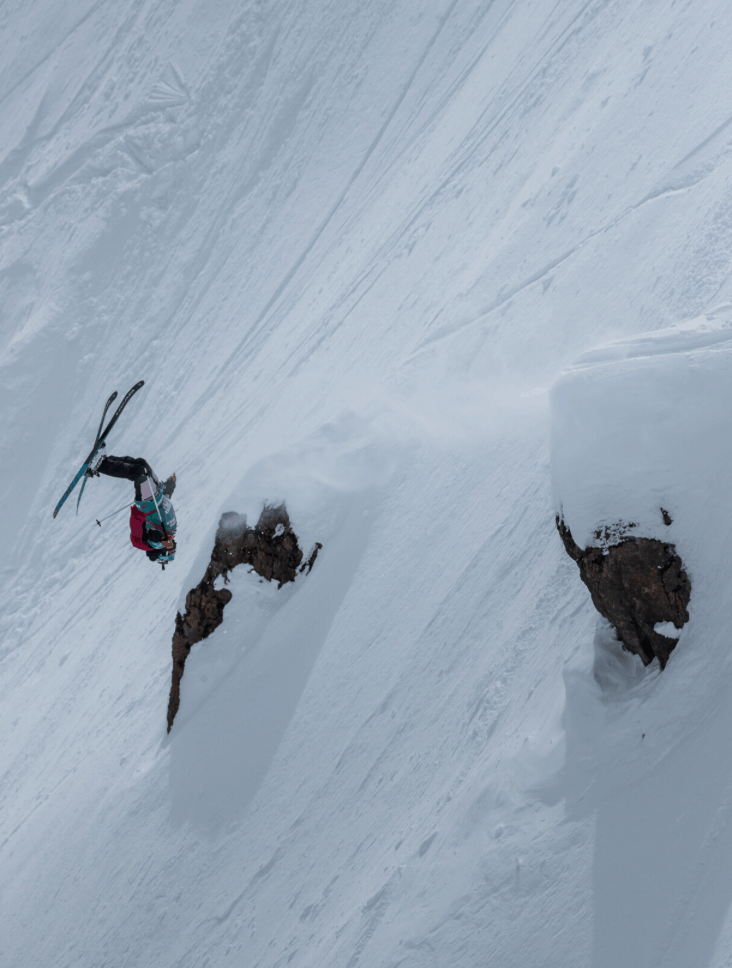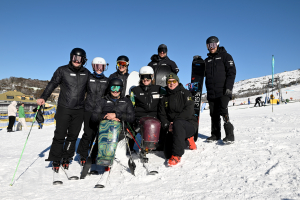The Freeride World Tour Kicks Off With A Great Event In Hakuba But Fans Unhappy With Delayed Webcast

Mountainwatch | Reggae Elliss
The first event of the 2020 Freeride World Tour ran in Hakuba, Japan on Sunday, with 41 competitors across four divisions competing in good conditions in the South Bowl in the Happo One side-country.
A good crowd was on hand to watch the event from a viewing area set aside underneath the Grad Chair at the top of Happo and they showed their appreciation of the athletes’ performance with plenty of cheering and applause. It was a great event to watch live, competitor throwing down some big moves, the good conditions and terrain complementing the creative, fast riding.
The start list was a mix of experienced athletes and rookies and including some of the legends of the sport – Tanner Hall, Drew Tabke, Elias Elhardt and current world champs Victor De La Rue, Marion Haerty and Arianna Tricone.
One of the crowd favourites was Australian snowboarder Michaela Davis-Meehan, a rookie on this year’s World Tour, and she didn’t disappoint, putting down a solid run to finish second behind defending champ Marion Haerty. Not a bad result for the first event while Eriki Vikiander from the US was third.

In the men’s snowboard Victor De La Rue set the standard early with an impressive run that included a massive laid-out backflip that had the crowd hooting. Victor was his usual smooth self, garnering an 83.67 from the judges, winning ahead of ahead of Nils Mindnich (USA) and Elias Elhardt (Ger) was third.
The skiing from both the men and the women was super impressive – fast, fluid and aggressive with two-time world champion Drew Tabke, USA, also launching a massive back-flip during his winning run, while second-place getter, New Zealand rookie Hank Bilous, skied a different line, which included a huge transition gap that had spectators hooting. SAs you can see from the clip below, no surprises Hank won the “Radical Moment” award.
“I was probably more stoked to make it over that transfer gap than I was to see my score!” said Hank. “It’s always hard to know definitively if those kind of gaps will actually line up from a visual inspection but it looked like it would work to me and I’m glad it did.”
Sweden’s Reine Barkered took out third place with a smooth run that also included a cleanly stomped massive back-flip.
In the women’s skiing Norway’s Hedvig Wessel, stepped up with good use of the terrain, some big flowing turns and a huge backflip which she stomped with ease. That run secured Hedvig first place ahead of 2019 Hakuba winner and World Champion Arianna Tricomi with Switzerland’s Elisabeth Gerritzen in third.

As I said earlier, it was a great event to watch live, but to do that you had to be on the mountain in Hakuba. In a decision that proved controversial, the FWT announced the day before the event that it would not be broadcast live and the results would be held back from the public for two days to coincide with the streaming of a produced package:
“We’re thrilled to announce a new, kick-ass condensed competition broadcast for Hakuba, Japan and Kicking Horse Golden BC events. We want to provide you with the best possible show without any weather delays, condensed with additional angles and interviews, streamed at an ideal time for all time-zones. The broadcast will therefore be streamed after the competition has taken place…”
The reaction from the FWT fan base was predictable, with an overwhelming negative response from fans who did not hold back on letting their feelings known via comments on the FWT Facebook and Instagram pages. The next event in Kicking Horse, Canada (Feb 6-12) will also not be live streamed, but the final three event in Europe – Andorra, Spain (Feb 28 – March 4), Fieberbrunn, Austria (March 7-13) and Verbier, Switzerland (March 28- April 5) will all have live streamed webcasts.
Of course, the obvious question is if the FWT was so, “thrilled with a new kickarse broadcast format,” why isn’t it also being used for the three European events? Most comments on the FWT social media believed it was a simple matter of cost and in an effort of damage control FWT host Lorraine Huber sat down with CEO Nicholas Hale Woods, for him to explain the rationale behind the decision. Turns out it is the unique weather of Hakuba and Kicking Horse.
In the short edit, Hale-Woods explained it as decision to get the best conditions for the riders. “Here in Japan, and in Canada, often weather windows are super short. If you look at the weather forecast during the week and you have to be ready at that time. If you are not ready and you have delays … you pass that window and the riders have to ride in flat light, not ideal conditions. And we wanted to avoid that.”
That sounds fair enough, but you’d have to think the same unpredictable weather variations happen at times in the European Alps, and as previous years have shown, it is not an insurmountable problem.
Whatever the thinking is behind the decision, it is a backward step for the sport and live broadcasts of all five events on the world tour should be a priority for the FWT. It has overcome weather and technical issues in the past and delays in the broadcast due to incoming cloud, lost skis etc. are all part of the sport – the fans know that. Look at pro surfing where an event will go on hold for days due to lack of swell or start times are delayed due to tide or wind variations. Surfing is also a good example of how live broadcasts have enhanced the sport’s growth and value for both fans and sponsors.
The mountains and weather are unpredictable and there are unique issues with which the FWT has to deal. However, knowing an event is done and dusted but not knowing the results for two days reduces the excitement and the experience of the whole tour for the audience.
The FWT did a great job with the condensed two-hour production of the Hakuba event and it is definitely worth watching. However, it will be difficult for the FWT to increase its audience and grow as a genuine international tour if it is one of the few sports you cannot watch live.




